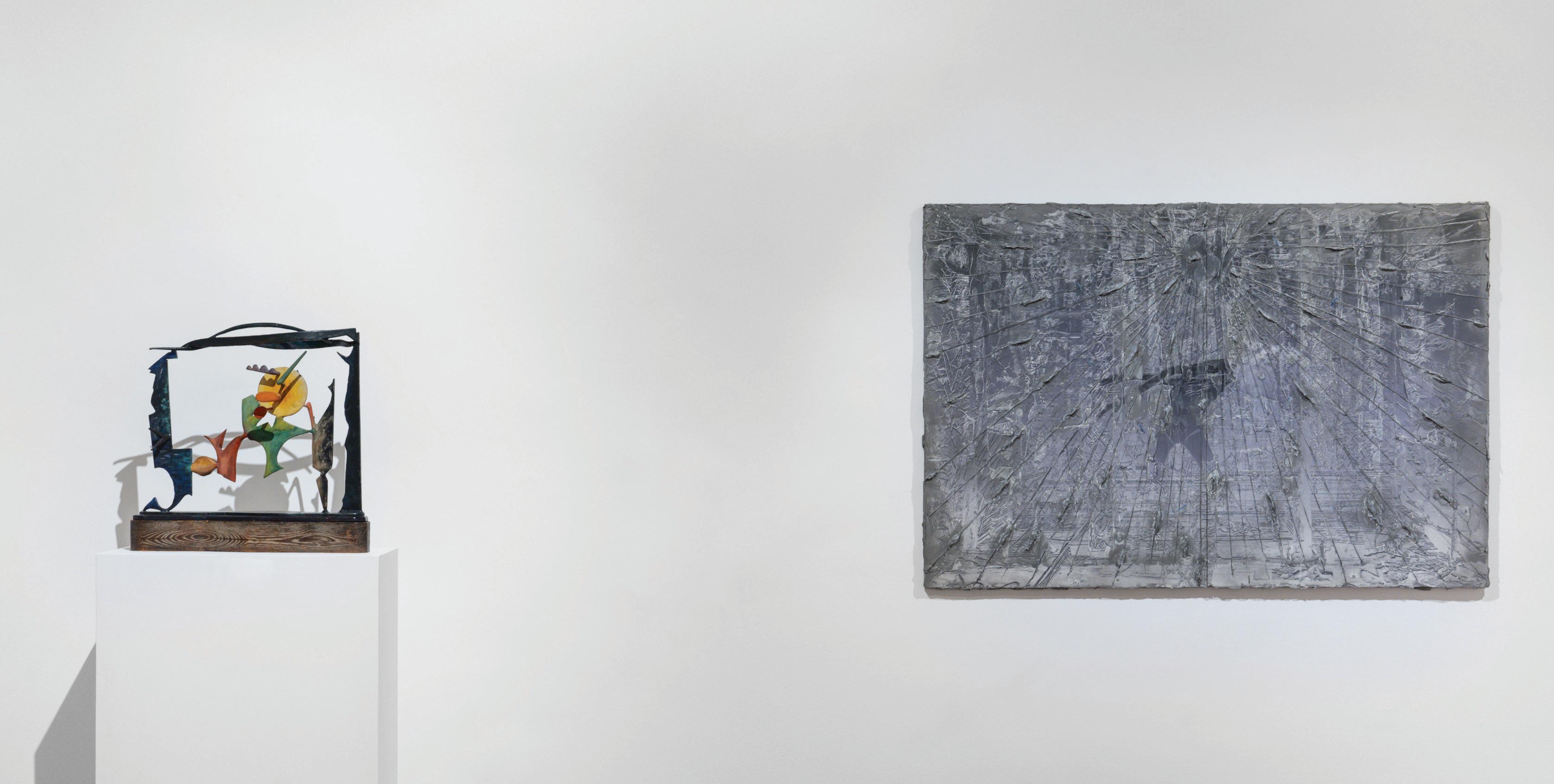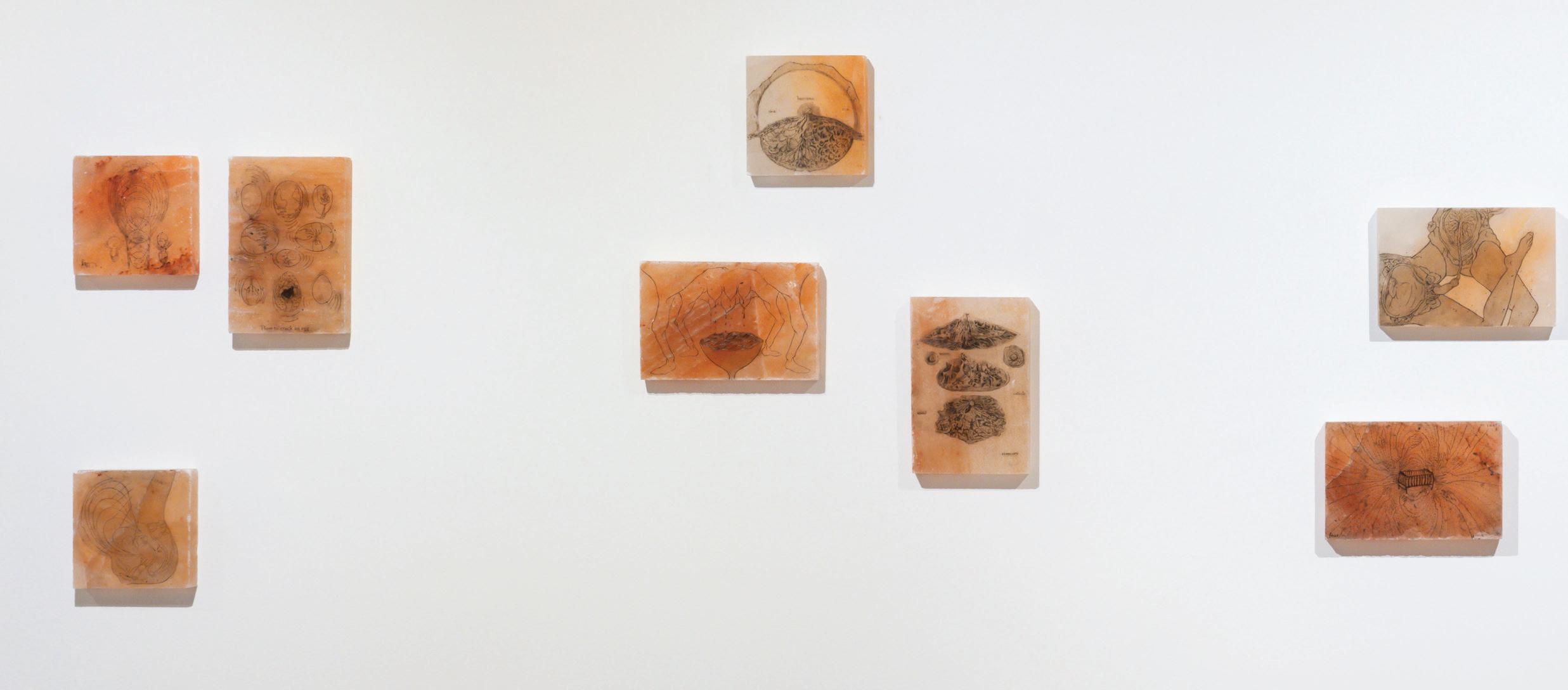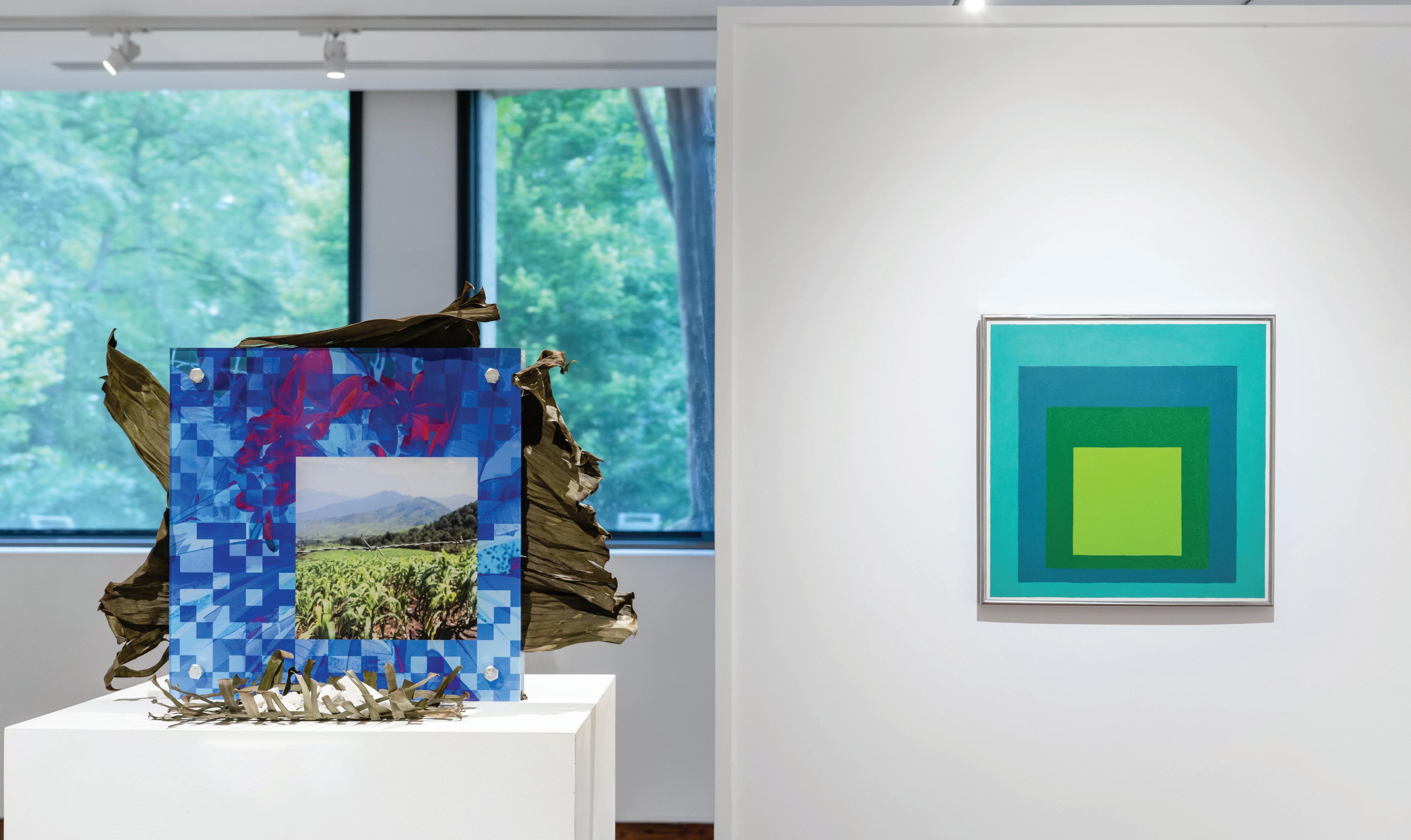
June 7th-August 23rd, 2025





June 7th-August 23rd, 2025



David and Carmen Kreeger were devoted patrons of the arts and the Washington, DC arts community. They supported countless Washingtonarea artists including Sam Gilliam, Simmie Knox, Thomas Downing, Gene Davis, Morris Louis, Ed McGowin, and Albert Stadler, purchasing their work at the Corcoran Gallery of Art biennials, area galleries, and directly from artists in the 1960s and early 1970s. The Collaborative is a guest artist exhibition program developed to support Washington-area artists.
“We are thrilled to be in partnership with artists and arts organizations across the city to present work of contemporary Washington-area artists. The Collaborative furthers our mission by supporting and spotlighting the immense talent of visual and performing artists in our city. We are honored to champion the work of these artists and provide many of them the opportunity to present their work in a museum for the first time.”
Helen Chason Director, The Kreeger Museum


Hamiltonian Artists’ mission is to nurture community and increase access to space, opportunity, and resources for emerging artists, through impactful programs and exhibitions. The organization reaffirms and expands upon its originating vision as an incubator for the professional development of emerging visual artists, serving as a hub for Washington, DC’s, creative economy and a vibrant center for contemporary art in the area. With its unique investment in artists, Hamiltonian Artists provides resources to aid their development in important business skills, professional experiences, and visibility to support and sustain their art career.
Through a two-year fellowship program, exhibitions, studios, artist talks, public events, membership program for art collectors at all levels, and so much more, the organization contributes to the vitality of the area’s arts scene by deepening the appreciation for contemporary art and culture throughout Washington, DC, and beyond.
During a preliminary walkthrough of The Kreeger Museum leading up to this collaborative exhibition, I came across the disorienting work of Jean Dubuffet. I was amused by the childlike rendering and sickly splotches of color present in his painting Water in the Gas (1961). Curiosity—and my lack of familiarity with the French language—led me to research each line of text painted into the scene, carefully typing each syllable into Google Translate: “balances truquées” (translation: rigged scales); “société l’espoir fait vivre” (translation: society—hope keeps us alive).
Working my way across the painting, I eventually arrived at the line “l’eau dans le gaz” which translates to water in the gas. With talk of an oncoming recession all over recent news reports, the first thing that came to my mind at the time was the urban legend that gas stations start watering down their gasoline during periods of economic downturn. Following the thread, I arrived—finally—at the point of departure that underpins this exhibition’s conceptual direction.
The phrase is an expression used when tension is rising in the atmosphere, or an argument is brewing. It is said the phrase can be traced back to the early 20th-century, when households used coal gas. High concentrations of water vapor would create pockets of water in the pipes, disrupting gas flow and causing small explosions. I was struck by this notion of sudden volatility caused by slow-building pressure, chains of cause and effect that fly below the radar until a disaster boils to the surface—at which point it is often already too late.
Moving across painting, sculpture, photo, textile, and installation, WATER IN THE GAS features seven contemporary works by Hamiltonian alumni Misha Ilin, Madyha J. Leghari, Edgar Reyes, and Isabella Whitfield, alongside seven 20th century works from The Kreeger Museum’s permanent collection. Spanning 1934 to 1965, this selection includes the work of artists Josef Albers, Max Beckmann, Jean Dubuffet, Fernand Léger, Joan Mitchell, David Park, and David Smith—artists whose lives and careers were closely impacted by power struggles that came to define the mid-twentieth century as one of geopolitical turbulence, sweeping economic change, and social upheaval. The areas of overlap in their personal histories form a dense tapestry of global impacts, and individual aftershocks.
Léger set out to create more socially conscious work after serving in World War I and returning with a head injury, later moving to America to avoid being drafted again. On the heels of the Great Depression and the outbreak of World War II, Park was relieved to find work as a wartime crane operator—up until a devastating construction accident left him with a debilitating back injury. Following the rise of Nazism and forced closure of The Bauhaus, Albers immigrated to the United States and became a U.S. citizen. As U.S. involvement in WWII intensified, Smith spent nearly every day of the week assembling tanks and locomotives. It was during this period that he developed the welding skills demonstrated in his groundbreaking steel sculptures, produced in rapid succession after he quit his all-consuming occupation. During WWII, Dubuffet was assigned to the meteorological division of the French army, his post located at the top of the Eiffel Tower. Continuing her education in painting, Mitchell moved to Paris just three years after WWII ended. She was met with food shortages, a cold apartment, and other harsh realities of post-war life in a major urban center.
Less than a lifetime later, artists living and working in the U.S. today are tasked with navigating what is widely considered to be another unprecedented moment in the nation’s history. Amid a sociopolitical backdrop of mass deportations, anti-abortion legislation, tech industry monopolization, institutional censorship, and more, Ilin, Leghari, Reyes, and Whitfield conjure artistic practices that carefully grapple with themes of language and migration; land and technology; perception and identity.
There is a dizzying sense of gravity compounded by the discursive space in which these timelines meet. Max Beckmann painted Children Playing in 1934, one year after being publicly denounced by the Third Reich. He was deemed a “degenerate artist,” forced to leave his teaching position in Frankfurt, his paintings at the Berlin National Gallery removed from view. In Beckmann’s work and several others on view, scenes that at first glance appear playful and lighthearted reveal distorted expressions, empty stares, and puzzling interactions. Here, youth, most often an uplifting symbol of hope and innocence, emerge as unnerving specters—embodying vulnerability and uncertainty. Situated alongside compositions that slide between order and chaos, their presence calls into consideration the ways in which present-day socio-political pressures give rise to generational implications.
The explosive climate we bear witness to today was born not from a sudden shift, but decades of mounting pressure that could soon give way to a fever pitch. WATER IN THE GAS invites viewers to reflect upon the cumulative effect of action and inaction, both individual and collective, that engender periods of upheaval. If the generations that follow will reap what we sow, exactly what seeds are being planted here and now? From fenced borders, radioactive rays, and class disparity to four-leaf clovers, Indigenous relics, and obstetric illustrations etched in salt stone—Hamiltonian Artists alumni point to what might be left behind for generations Z and Alpha.
Anisa Olufemi Director of Programs and Curator, Hamiltonian Artists



https://mishailin.com/ @ilyin.mike
Misha Ilin (b. 1985; Protvino, Russia) is an interdisciplinary artist working across installation, performance, sculpture, and writing. He interrogates communicative divides within political, ecological, and economic systems, examining how constructed realities arise under conditions of authority, bureaucracy, and control. Frequently incorporating instructional prompts as participatory tools, Ilin positions his projects as a form of social inquiry, bridging personal narratives with larger systemic structures. Ilin studied art at the National Center for Contemporary Art in Moscow. In 2016, he moved to the United States to pursue his Master’s in Fine Arts. Ilin is a recipient of the Research and Publication Grant from Washington Project for the Arts (2023). His recent exhibitions include Pale Grass Blue at Hamiltonian Artists (Washington, DC); Wish the Past Never to Repeat Itself at The Kitchen (Berlin, Germany); and Inquisitive Instructions at the Modern Art Museum (Shanghai, China). Misha Ilin currently lives and works in New York.

“the room (2025) is part of a body of work built on the idea that ecocide, war, body politics, technological advancement, religion, and capital function as radioactive events—forces that alter and reshape the genome of what we call reality. In this piece, I employ AI and incorporate hieroglyphic qualities to critically engage with the almost religious faith placed in new technologies and confront a key controversy surrounding their use: the potential reliance on nuclear power as an energy source. The interior space, childlike figure, and radiating, sun-like form—either cutting through or emerging from the surface of the work—are distorted nearly to the point of abstraction. These elements are set against an AI-generated background, created by repeatedly inputting the nonsensical prompt “necropolitics of dark ecology in pleasure graphics of pervercity” into a popular text-to-image model. Rooted in a philosophical inquiry of how language articulates reality, this recursive act becomes part of the work’s exploration of meaning-making, power, and technological mediation.”
- Misha Ilin

Ilin ratking (detail), 2025, ceramics and enamel.
The Rat King phenomenon, in which rats or mice are found entangled by their tails, dates back to the medieval period. This ceramic sculpture draws inspiration from historical documentation and the metaphorical significance of the rat king as a dark omen linked to disease and bleak times—most notably in E. T. A. Hoffmann’s tale of the Mouse King and its adaptation in Pyotr Tchaikovsky’s ballet The Nutcracker. Although sightings are rare—especially those involving live specimens—in 2021, a living “rat king” consisting of five mice was captured on video near Stavropol, Russia.
According to the video’s narrator, the mice were discovered on a farm after irrigation flooded their burrows. The narrator speculates that the mother brought her young above ground and onto a field, entangling their tails around a plant shoot to prevent them from being swept away. Another video captures the moment some of the mice began to drown, prompting the narrator to untangle the formation. Once released, the young quickly dispersed in different directions. Interpreting its form as a social metaphor, ratking (2025) explores life’s often unsettling interconnectedness—the simultaneous longing for freedom and the unavoidable dependence on the actions of others.
- Misha Ilin
https://www.madyhaleghari.com/ @madyhaleghari
Madyha J. Leghari (b. 1991; Multan, Pakistan) is a visual artist, writer, and educator working between Lahore and Washington, DC. She holds a BFA from the National College of Arts, Lahore, and an MFA from the Massachusetts College of Art and Design through a Fulbright scholarship. Her multidisciplinary practice interrogates the possibilities and limits of language and the body, occupying the interstices of poetry, post-humanism and semantic play. Leghari has been recognized with numerous prestigious fellowships and residencies, including the Hamiltonian Artists Fellowship, Wherewithal Research Grant, Islam & Print Fellowship, Delta Research Placement at Flat Time House, and Siena Art Institute Residency. Her work has been exhibited internationally at venues such as the Pera Museum, Karachi Biennale, University of Colorado Boulder, and Bennington College, spanning the Americas, Asia, and Europe. Her work has been featured in The Washington Post, Artforum, and The News Pakistan. She has taught at the National College of Arts, Lahore; the Massachusetts College of Art and Design; and Beaconhouse National University.


J. Leghari, sick, stroke, sea, swell, 2025, drypoint etching on ‘Himalayan’ rock salt.
sick, stroke, sea, swell (2025) focuses on the experience of pregnancy—a condition in which the body becomes multiple, time folds in unfamiliar ways, and the boundary between self and other is breached. The etchings are arranged in four clusters, each engaging with a distinct but interconnected dimension of gestation: nausea (sick), touch (stroke), uterine expansion (swell), and lactation (sea). Each cluster marks a phenomenological threshold: nausea as a disorientation of space and equilibrium; touch as a paradox—felt from the inside and sensed by more than one; expansion as the architecture of care taking shape from within; and lactation as liquidity, as tide, as a sea circulating through skin.
Formally, the work draws from the visual language of historical anatomical studies, abstraction, and diagramming. This work features pink rock salt—often misnamed “Himalayan” salt—as both material and metaphor. Mined almost exclusively in Pakistan, these salt deposits are remnants of an ancient shallow sea that flowed through the region 800 million years ago. Today, the same salt circulates in wellness culture, its deep geological history obscured by exotic branding that enhances its market appeal. The work draws attention to this erasure, echoing broader patterns of extractivism: how we mine meaning, labor, and life from both the earth and the maternal body.
-
Madyha J. Leghari

https://reyesedgar.com/ @reyesedgar
Edgar Reyes (b. 1990; Guadalajara, Mexico) is a multimedia artist and professor based in Baltimore, Maryland. His work invites viewers to think about the people, places, and connections they carry with them. Reyes’ practicdraws on the specifics of his own life and reflections of shared experiences of resettlement and migration. Through his art-making, he explores his family’s Mexican and Indigenous roots. Reyes earned his MFA from the Maryland Institute College of Art and has taught at nonprofit organizations, schools, universities, and museums. His work has been prominently featured in large-scale public installations and in galleries and public spaces across the United States. In recent years, Reyes’ work has been exhibited and collected by various museums and institutions, including The Walters Art Museum and Johns Hopkins University.

“Inspired by my research and travel to Mexico and Guatemala, La Tierra Nunca Olvida (The Land Never Forgets) (2025) investigates the duality of eco-tourism and its societal impacts. It questions the cost and benefits of such ventures. Who profits and who is displaced? What has driven families to leave their breathtaking ancestral lands? Is it safety and economic stability? The work highlights the stark contrast between those who remain, often adapting their traditional trades to cater to a globalized tourism market, and those compelled to migrate. It also meditates on the fascinating linguistic shifts occurring in these regions, where English now intertwines with Spanish and Indigenous languages, reflecting a new cultural landscape. Here, I explore the connections between migration and our collective environmental footprint.”
- Edgar Reyes

“Güero (2025) explores the impact of globalization on migration. A banana tree, prominent in the background, symbolizes the significant role outside forces have played in economic growth across Mexico and Central America. Even as an introduced species to the Americas, it has played a profound role in shaping the history of these regions—even embedding itself in culinary traditions. Overlaid shapes filter distinct colors, the geometric design inspired by Indigenous weaving traditions that transcend national borders. A blurred portrait of myself as a first-grader hints at how environmental and social pressures, often stemming from regional development, push families to migrate. The piece contemplates the interconnectedness of history, culture, and the human experiences of displacement and adaptation.”
- Edgar Reyes
https://www.isabellawhitfield.com/ @isabella_whitfield_
Isabella Whitfield (b. 1998; Centreville, Virginia) is a multidisciplinary artist based in Virginia, working in papermaking, sculpture, and site-responsive installation. Her work explores how the function and history of objects can be abstracted through material, repetition, and context. After earning BAs in Sculpture and Politics from the University of Virginia, she completed a postgraduate year as an Aunspaugh Art Fellow. Whitfield exhibits primarily in the DMV area and has been a resident artist with Penland, Anderson Ranch, Ox-Bow, Pyramid Atlantic, VisArts Richmond, and VisArts (Rockville). She was a 2022–2024 Hamiltonian Fellow and is currently a Papermaking Associate at Pyramid Atlantic.

“I am interested in four-leaf clovers both a symbol of luck and as a result of genetic mutation, an error whose frequency can increase based on environmental factors. By collecting and embedding 30 four-leaf clovers in handmade paper, I patch together a makeshift Punnett Square in which the recessive trait becomes dominant and the former dominant trait becomes non-existent. This process explores how luck (arguably a gentler term for fate) can feel hereditary, uncontrollable, and inevitable. Though carefully executed, the hand stitching is slightly arrhythmic, the seams acquiring a mark-making, painterly quality. When I was younger, finding four-leaf clovers felt like a magical accomplishment, a sign of divine favor or promise for future blessings. Collecting them now feels less about hope and more about groundless determination, though still retaining a kind of naive optimism.”
- Isabella Whitfield
“Over the past several years, I have adopted endurance as a key value in my practice, often relying on willpower rather than spontaneous inclination to create artworks. By casting 300 replicas of an ambiguously Asian garden figurine gifted by my aunt, I wanted to play with the obfuscation of identity through multiples. These figurines are overlaid with pulp from paper sculptures shown in my 2024 Hamiltonian Artists exhibition. I like to reimagine materials from past projects as it enables me to simultaneously hold onto and release old ideas. All My Children Are Good People reflects on how we create physical environments that reinforce internal self-conceptions, investigating the dissonance between reality and the narratives we choose to tell. Through repetition and the material reprocessing, I consider how these narratives evolve, each carrying numerous, often contradictory truths.”
- Isabella Whitfield


The Kreeger Museum
Washington, DC
June 7th - August 23rd, 2025
This catalogue was produced in conjunction with an exhibition featuring alumni from Hamiltonian Artists’ fellowship program, and organized by The Kreeger Museum.
Published in the United States by The Kreeger Museum 2401 Foxhall Road NW Washington, DC 20007 www.kreegermuseum.org
Helen Chason, Director, The Kreeger Museum
Katherine Capristo, Designer
Anisa Olufemi, Curator
Hamiltonian Artists 1353 U Street Northwest, Suite 101 Washington, DC 20009 hamiltonianartists.org
Lily Siegel, Executive Director
Anisa Olufemi, Director of Programs and Curator
Image Credits:
AllimagesarecreditedtoVivianMarieDoering.
Copyright © 2025 The Kreeger Museum All rights reserved. This publication may not be reproduced without written permission from The Kreeger Museum.